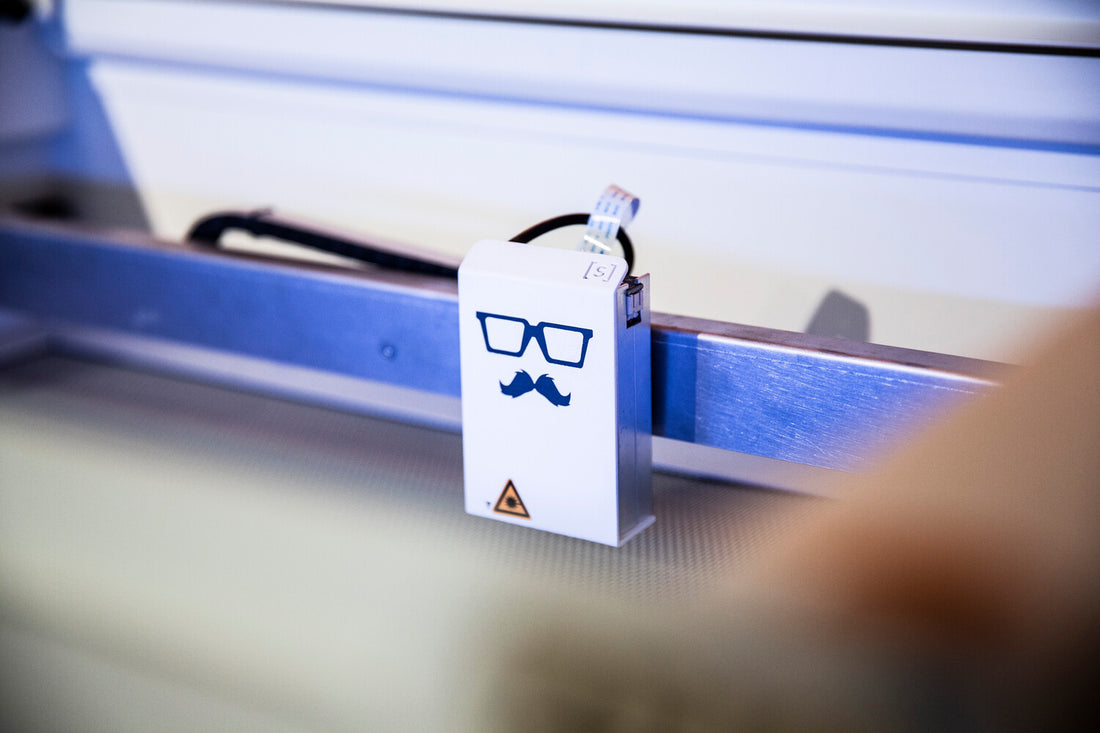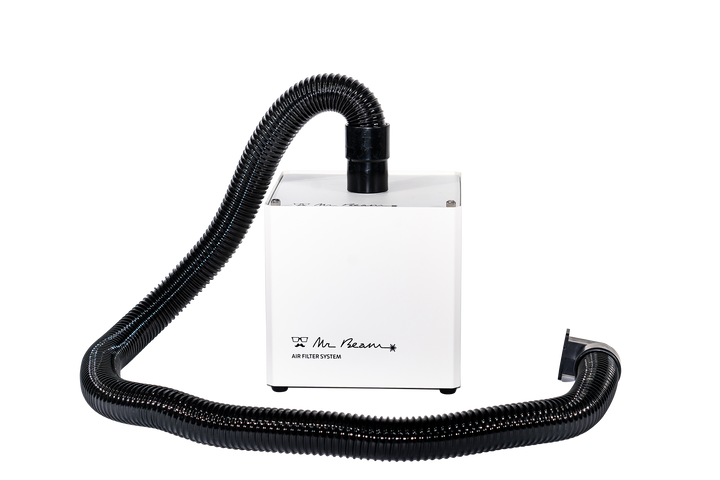The core of our laser cutter technology: the diode laser

Our Mr Beam Laser cutter is constructed user -friendly. This includes that the core of each machine is inexpensive and easy to exchange. The semiconductor lasers used by us are also characterized by a low installation height and a good efficiency. This means that a large part of the thermal energy actually in the cutting and engraving work passes And the component is not excessive. Nevertheless, every laser diode is equipped with a heat sink. The heat sink consists of several components. For example, the copper block of the heat sink must never be removed. Once expanded, it can no longer be assembled without professional help! In our Knowledge database Let us explain exactly what with the Laser head cleaning everything must be observed.
What is a laser?

A laser is an apparatus to create electromagnetic waves with the same frequency, the same direction, the same phase and the same polarization. Electromagnetic wave radiation, which also includes visible light, is usually only scattered. You can bundle them with a lens. However, the rays run apart again behind the focal point. To combine light permanently in a single beam and the Exploitation of the laser effect (Light Amplification Due to Stimulated Emission of Radiation), a high technical effort is necessary. The idea for the laser beam had none other than Albert Einstein. Based on his findings, initial attempts to produce laser beams were made in the 1930s. Little has changed in the basic design of powerful lasers since then. They consist of a transparent, cylindrical -shaped single -crystal, e.g. B. ruby.
This is mirrored on the two sides. A spiral flash lamp is attached around the crystal. If this lights up, it creates a standing light wave in the ruby. The photons in this standing wave of light stimulate the emission of other photons from lively electrons. The more photons between the mirrors rush back and forth at the speed of light, the more the photons spread in the resonator and the wave of light. Slightly focused through a lens. One of the two mirrors is not completely mirrored and therefore lets a small proportion. Behind it, the laser beam continues to continue in an exact line. A typical CO2 laser is usually very large in the construction and also has other disadvantages. The loss of performance over time, water cooling and the lower accuracy of the laser compared to other models make this laser somewhat unattractive. Therefore, the diode laser was invented. How exactly a laser works, we have detailed in this Blog article, already explained.
What is a diode laser?
A laser diode is closely related to the LEDs, the light -out diodes (Light Emitting Diodes). The main difference is that a diode laser for the emission of short -wave laser light is designed. Since diodes are always semiconductors, these laser types are also called "semiconductor lasers".
In terms of performance, a laser diode was also weaker than the large laboratory lasers for a long time. They were only used as a pointer or reading head for CD players. In the meantime, that has changed. A high -energy laser diode as we use is Probably able to cut material and engrave.
Construction of the laser diode
A semiconductor laser consists similar to a LED of a crystal body and a power source. An end is fully mirrored, the other is not completely mirrored. This creates the desired optical resonator. The standing light wave forms within the mirror surfaces when supplying a power. Half -conductor lasers of today create an even, continuous ray. For some applications, a pulses laser is sometimes required. - No continuous beam is generated in a pulse laser.
The standing wave of light is created Due to the optical resonator between the mirrors. In the case of laser diodes, the energy supply is electrically regulated. The electricity is limited so that the laser diode does not immediately destroy itself due to the low internal resistance. One possibility would be to switch the current on and off quickly. At the Mr Beam This is not necessary. The electricity is regulated by a laser driver, an electronic circuit board. We have these at Mr Beam self developed.
The laser beam itself leaves the component on its front edge. Therefore, LED and laser diodes are also called "edge emitter". The light is broadcast across the course of the electrical current in the component itself. The efficiency in a special Powerful laser diode is between 25 - 50 %. Of the Mr Beam is about 30 %. A CO2 laser has a much poorer efficiency in comparison. The rest is generated as heat. A diode laser therefore always requires to be adapted cooling. In the medium power range, an aluminium heat sink is sufficient, which is attached to the laser diode with thermal paste. In the case of a stronger diode laser with more than a thousand watts, active cooling with air and heat pipes, water, glycol or even liquid nitrogen is required. Good cooling always extends the laser diode life.
For the Construction of the laser diode As it is used in our devices, this results in a constructive challenge. On the one hand, the laser diode must be strong enough to burn, melt or evaporate the material for cut or engraving. On the other hand, the emitter must be small enough so that the cut does not become too wide. The smaller the emitter, the more difficult it is to lead the heat away from the laser diode. Solve cooling with heat pipes is disadvantageous. We have invested a lot of research and development work to optimally solve this challenge. Nevertheless, the high temperatures at a laser diode have a permanent effect on the component. This cannot be avoided with the best materials and the most sophisticated design. With a lifespan of 10,000 hours, however, we have reached a value with which our laser cutter can deliver the best results for a period of 3.4 years at an 8 -hour operation per day. From 10,000 laser hours, the performance of our laser head is 80 % compared to a new one Mr Beam Laserkopf.
The diversity of the diode laser
The structure of the laser diode determines the wave area in which the component works. It depends above all on the crystal core. Depending on which material is installed there, the diode laser receives different properties and performance data. The colour of the laser light is now very diverse. The most common colours are red, blue or white. But there is also violet (405 Nm), turquoise (462 Nm), green 532 Nm) and in the nearby infrared area between 808 and 1560 Nm.
- Red diode laser are Easy and inexpensive to manufacture. They are available in different wave areas. They are mainly used for laser points, laser scanners or as reading heads for CD players.
- The Blue laser diode creates laser light in one Wavelength of 445 to 455 nanometres. Indium-gallium-nitride is used as the material for the semiconductor. The laser diode is used in DLP, for example, in DLP or cars in front of the cars. In addition, our engraving and cutting lasers work in this light spectrum.
- The Violet laser diode, For example, is used for Blu-ray and HD-DVD drives
- White laser is very high -energy. You are used in gas spectrometers.
Dealing with a laser cutter

When dealing with lasers from laser class 3, the wearing of special safety glasses is prescribed in research and industry, since eyelid reflex is no longer sufficiently protected. With radiation of more than 5 MW, which is accessible to the eye, it is therefore imperative. When looking at the sun directly, it is 1 MW in comparison. The safety glasses absorb and / or reflect the incident laser light so strongly that it can no longer harm your eyes. When reflecting, the light may damage the eyes of a third party. You can do without this when operating our laser cutter. We have designed our devices in such a way that it is ensured in every operating situation that no laser light leaves the housing. Our Mr Beam Laser cutter Only works if the orange protective flap of the device is closed. If you open the flap during the cutting or engraving operation, the device stops immediately and switches off the power supply on the laser head and thus the blue laser diode. This is one of many reasons why ours Laser list of laser class 1. - Incidentally, no laser protection officer is necessary! - As with the operation of a DVD burner.
With the Mr Beam Can you many ones Laser applications execute. Regardless of whether engraving stones, Cut the felt or Laser wood. - The possibilities are really diverse. Due to the user -friendly operation and safety precautions, the use of the MR Beam is very interesting for many industries and areas. You can Mr Beam Laser cutter e.g. optimally in Schools, at trade fairs or simply use in the office. - thanks to laser class 1.





